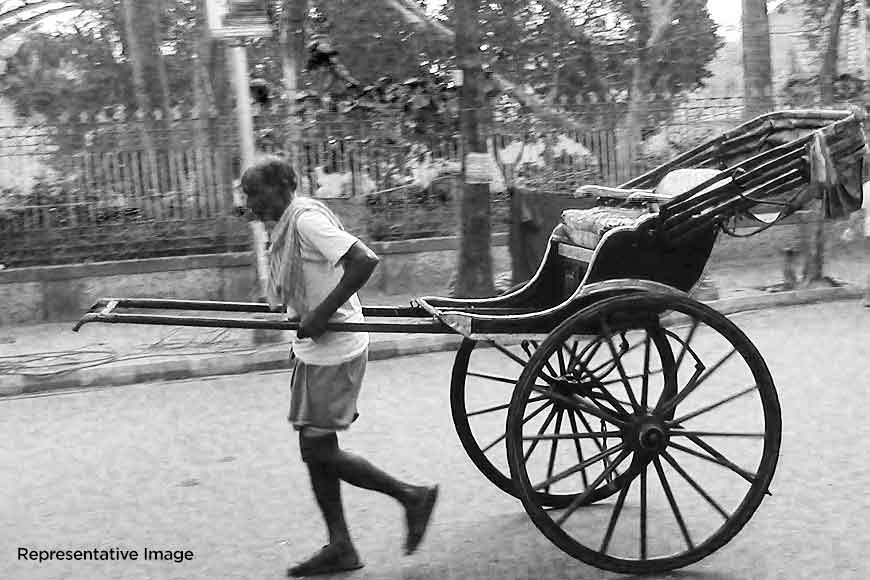Kolkata’s hand-pulled rickshaws survived since 1800s and came as a rescue during COVID-19

Rickshaw pullers of Kolkata have always come to the rescue of residents. Be it monsoon rains or supplying materials during COVID 19 lockdown from house to house, they have been the messiah for all citizens. Close to 1,000 hand-pulled rickshaw pullers still ply in the narrow lanes and by-lanes of North and Central Kolkata daily. They are the lifeline of the city and come to the rescue whenever there is a crisis that hits the modern metropolis.
During the ongoing pandemic, the hand-pulled rickshaw pullers have emerged as the new frontline Covid-19 warriors because they are entering dangerous containment zones to ferry sick patients, deliver medicines, groceries, LPG cylinders, and other essential goods. Kolkata is indeed a city of paradoxes. The first city in India to introduce Metro rail, it is also the only city now in the world that continues to operate licensed hand-pulled rickshaws (called tana rickshaw in Bengali) as a mode of public transport.
The hand-pulled rickshaw is a vestige of the colonial past, which was introduced in India by the British way back in the 1800s. The word ‘rickshaw’ derives its name from the Japanese word ‘Jin-riki-sha’ (jin meaning human, riki meaning power, and sha meaning vehicle, which translates to human-powered vehicle). However, in India, human-powered vehicles had existed earlier even before the rickshaws in the form of the palki (palanquin). The palki was carried on shoulders by four bearers and was an efficient means of transport before the hand-pulled rickshaw was introduced. The popularity of palkis declined with the introduction of other modes of transportation, including horse-drawn buggies, bicycles, hand-pulled rickshaws, and mechanised public transport like trams and railways.
The hand-pulled rickshaw was invented in Japan in 1869 and was introduced in China by 1874. The following decades witnessed a boom of hand-pulled rickshaws in Japan, China, Singapore, India, Indonesia and Malaysia. They served as an economical means of transportation and employed millions of poor working-class families living in cities.
Calcutta’s pre-eminent position as the capital of British India played a vital role in the development of public transportation in the city. The East India Company was involved in opium trade with China, and Calcutta already had a significant Chinese population. During 19th and early 20th century, there was an influx of Chinese immigrants from British colonies like Canton, Shanghai, and Hong Kong, who relocated to Calcutta to flee the devastating famines and political unrest in China. These new immigrants introduced the rickshaw to Calcutta. The hand-pulled rickshaw had already been around a couple of decades earlier in Shimla.
In 1919, the Hackney Carriage Act was passed by the British allowing hand-pulled rickshaws to be hired as a passenger transport vehicle in Calcutta. After World War II, colonialism declined in Asia, and the hand-pulled rickshaw faded out of use. Strangely, however, the legacy of rickshaws continued in Calcutta long after the British Empire was gone (1947), and long after the communist government in China banned (1949) the use of rickshaws. Not only did it survive in Calcutta but the tenacious hand-pulled rickshaw has become an icon of the metropolis.
There was a move by the previous Left Front Government to ban hand-pulled rickshaws, a move that would have robbed the livelihoods of more than 10,000 rickshaw pullers. But in 2012, the Kolkata Municipal Corporation decided to issue photo identity cards to the 6,000-odd rickshaw pullers of the city. This move was taken to secure safety of the passengers and to ensure unnecessary harassment faced by rickshaw pullers on the streets of Kolkata. They have lived as our neighbours for more than a century now and have been a witness to the changing profile of the metropolis, taken all odds on their stride and continue to provide us solace and service during our hour of need. They are our friendly neighborhood companions, a permanent fixture of this mega-city.










